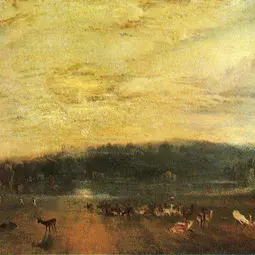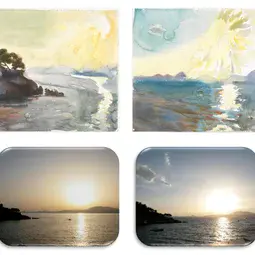Famous paintings help study the Earth’s past atmosphere
A team of Greek and German researchers has shown that the colours of sunsets painted by famous artists can be used to estimate pollution levels in the Earth’s past atmosphere. In particular, the paintings reveal that ash and gas released during major volcanic eruptions scatter the different colours of sunlight, making sunsets appear more red. The results are published today in Atmospheric Chemistry and Physics, an open access journal of the European Geosciences Union (EGU).
When the Tambora volcano in Indonesia erupted in 1815, painters in Europe could see the colours of the sky changing. The volcanic ash and gas spewed into the atmosphere travelled the world and, as these aerosol particles scattered sunlight, they produced bright red and orange sunsets in Europe for up to three years after the eruption. J. M. W. Turner was one of the artists who painted the stunning sunsets during that time. Now, scientists are using his, and other great masters’, paintings to retrieve information on the composition of the past atmosphere.
“Nature speaks to the hearts and souls of great artists,” says lead-author Christos Zerefos, a professor of atmospheric physics at the Academy of Athens in Greece. “But we have found that, when colouring sunsets, it is the way their brains perceive greens and reds that contains important environmental information.”
Zerefos and his team analysed hundreds of high-quality digital photographs of sunset paintings done between 1500 and 2000, a period including over 50 large volcanic eruptions around the globe. They were looking to find out whether the relative amounts of red and green along the horizon of each painting could provide information on the amount of aerosols in the atmosphere.
“We found that red-to-green ratios measured in the sunsets of paintings by great masters correlate well with the amount of volcanic aerosols in the atmosphere, regardless of the painters and of the school of painting,” says Zerefos.
Skies more polluted by volcanic ash scatter sunlight more, so they appear more red. Similar effects are seen with mineral (desert dust) or man-made aerosols. Air with a higher amount of aerosols has a higher ‘aerosol optical depth’, a parameter the team calculated using the red-to-green ratios in the paintings. They then compared these values with those given by independent proxies such as ice-core and volcanic-explosivity data, and found good agreement. The results obtained validate those of the team’s previous study, published in Atmospheric Chemistry and Physics in 2007.
To further support their model, the researchers asked a famous colourist to paint sunsets during and after the passage of a Saharan dust cloud over the island of Hydra in June 2010. The painter was not aware of the dust event. The scientists then compared measurements of the aerosol optical depth made by modern instruments with those estimated from the red-to-green ratios of the paintings and of digital photographs, and found that they all matched well.
Since aerosols scatter sunlight, less of it reaches the surface, leading to cooling. The Tambora eruption, the largest in recorded history, killed some 10,000 people directly and over 60,000 more due to the starvation and disease during the ‘volcanic winter’ that followed. Aerosol optical depth can be directly used in climate models, so having estimates for this parameter helps researchers understand how aerosols have affected the Earth’s climate in the past. This, in turn, can help improve predictions of future climate change.
“We wanted to provide alternative ways of exploiting the environmental information in the past atmosphere in places where, and in centuries when, instrumental measurements were not available,” concludes Zerefos.
###
Please mention the name of the publication (Atmospheric Chemistry and Physics) if reporting on this story and, if reporting online, include a link to the paper (http://www.atmos-chem-phys.net/14/2987/2014/acp-14-2987-2014.html) or to the journal website (http://www.atmospheric-chemistry-and-physics.net/).
More information
This research is presented in the paper ‘Further evidence of important environmental information content in red-to-green ratios as depicted in paintings by great masters’ published in the EGU open access journal Atmospheric Chemistry and Physics on 25 March 2014.
Full citation: Zerefos, C. S., Tetsis, P., Kazantzidis, A., Amiridis, V., Zerefos, S. C., Luterbacher, J., Eleftheratos, K., Gerasopoulos, E., Kazadzis, S., and Papayannis, A.: Further evidence of important environmental information content in red-to-green ratios as depicted in paintings by great masters, Atmos. Chem. Phys., 14, 2987-3015, doi:10.5194/acp-14-2987-2014, 2014.
The team is composed of C. S. Zerefos (Academy of Athens, Athens, Greece &Navarino Environmental Observatory [NEO], Messinia, Greece), P. Tetsis (Academy of Athens), A. Kazantzidis (Laboratory of Atmospheric Physics, Physics Department, University of Patras, Greece), V. Amiridis (Institute of Astronomy, Astrophysics, Space Application and Remote Sensing, National Observatory of Athens, Greece), S. C. Zerefos (Hellenic Open University, Patras, Greece), J. Luterbacher (University of Giessen, Germany), K. Eleftheratos (Faculty of Geology and Geoenvironment, University of Athens, Greece), E. Gerasopoulos (NEO & Institute of Environmental Research and Sustainable Development [IERSD], National Observatory of Athens, Greece), S. Kazadzis (IERSD), and A. Papayannis (National Technical University of Athens, Athens, Greece).
The European Geosciences Union (www.egu.eu) is Europe’s premier geosciences union, dedicated to the pursuit of excellence in the Earth, planetary and space sciences for the benefit of humanity, worldwide. It is a non-profit interdisciplinary learned association of scientists founded in 2002. The EGU has a current portfolio of 16 diverse scientific journals, which use an innovative open access format, and organises a number of topical meetings, and education and outreach activities. Its annual General Assembly is the largest and most prominent European geosciences event, attracting over 11,000 scientists from all over the world. The meeting’s sessions cover a wide range of topics, including volcanology, planetary exploration, the Earth’s internal structure and atmosphere, climate, energy, and resources. The 2014 EGU General Assembly is taking place is Vienna, Austria from 27 April to 2 May 2014. For information regarding the press centre at the meeting and media registration, please check http://media.egu.eu.
If you wish to receive our press releases via email, please use the Press Release Subscription Form at http://www.egu.eu/news/subscribe/. Subscribed journalists and other members of the media receive EGU press releases under embargo (if applicable) 24 hours in advance of public dissemination.
Contact
Christos Zerefos
Member of the Academy of Athens & Professor of Atmospheric Physics
Academy of Athens, Greece
Phone +30-210-8832048
Mobile +30-6944-570099
Email zerefos@geol.uoa.gr
Bárbara Ferreira
EGU Media and Communications Manager
Munich, Germany
Phone +49-89-2180-6703
Email media@egu.eu
Links
- Scientific paper
- Journal – Atmospheric Chemistry and Physics
- Read this press release in simplified language, aimed at 7–13 year olds, on our Planet Press site



